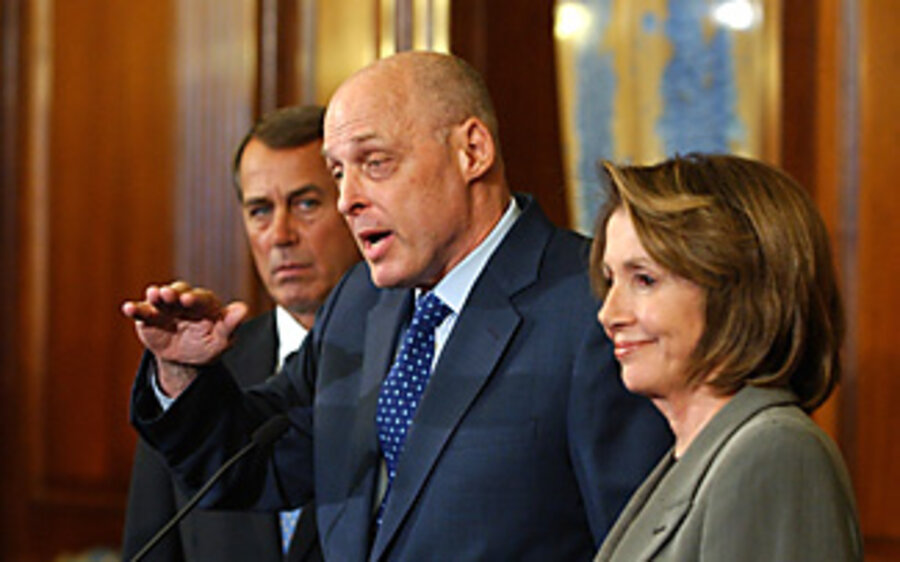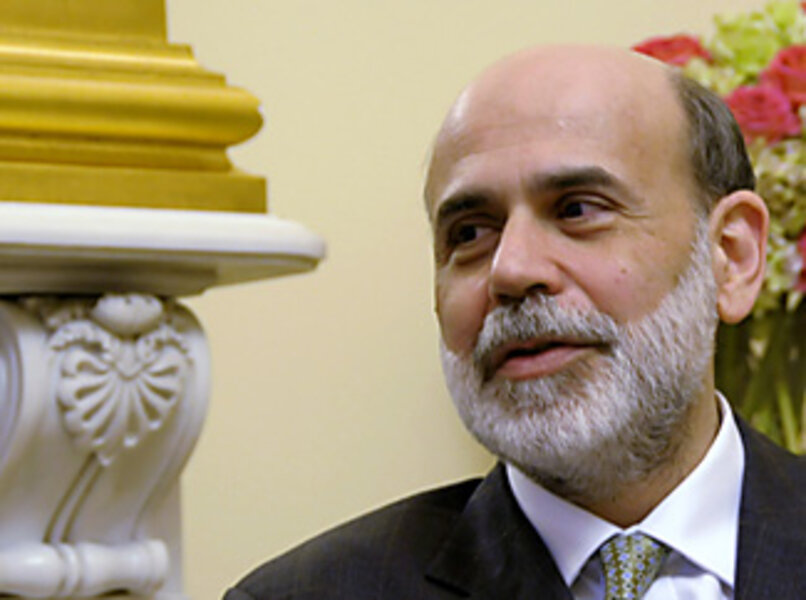Fed's tough call: how far to cut interest rates
Loading...
| New York
A newly aggressive Federal Reserve is poised to take its next push to jump-start the US economy.
But how hard to push comes at a sensitive moment for the economy. Cut interest rates too little and already jumpy markets could plunge, worsening an economic slump. Cut rates too much and, because of the lag time involved, the central bank risks overheating an economy later in the year.
That is why only a week after the central bank cut interest rates by three-quarters of a percentage point, Fed watchers are divided over how much it will knock down rates: Some say only one-quarter of a percentage point; others expect the Fed to go with half a percentage point.
The size of the rate cut can mean a big difference in the long run, affecting everything from what businesses pay for financing expansion to the interest Americans pay on their credit cards.
A week ago, many economists had expected the Fed to go with the larger rate cut. But since then, the US House has proposed a $150 billion stimulus package, which might well grow once it passes the Senate. Financial markets remain unsettled but are not in free fall as they were last week. And economists believe any cut now can be followed up with more cuts in the future if the economic indicators continue to weaken.
"I think they will cut rates, but will only go with a quarter of a percent," says Lyle Gramley, a former Fed governor and a consulting economist at Stanford Group in Washington. "They can leave the door open for more."
The challenge is that Fed cuts take at least nine months to work their way through the economy. So if central bankers overreact now and the economy rebounds in the fall, they could worsen inflation. However, if the Fed does not cut rates now, some economists argue it could deepen the slowdown.
"If the Fed does not act, the markets will react much more harshly than they have," says Keith Hembre, chief economist at First American Funds in Minneapolis. "It would suggest the economy would be in a deeper downturn if they did nothing."
However, Mr. Hembre says any bounce to the economy will also depend on how quickly the economic-stimulus package gets approved by Congress. "By the time they distribute the checks, it might be May. So by the third quarter we could see a boost to personal disposable income," says Hembre.
The Fed's decision comes at a time when fresh indicators are giving a clearer picture of the direction of the economy. On Monday, the Commerce Department reported that new home sales in December fell 4.7 percent. For all of 2007, new home sales were off a record 26.4 percent. Prices rose only 0.2 percent, the worst showing in 16 years.
On Tuesday, the Fed will also get a look at December durable-goods orders, considered to be an indicator of future economic activity. The overall number is expected to grow because of strong year-end sales of aircraft. Even without aircraft it's expected to grow by over 1 percent. "However, if that number is down, then the Fed will drop rates by half a percentage point," says Mr. Gramley.
Before the Fed makes its announcement, it will also get a chance to see the Commerce Department's preliminary estimate of the growth rate of the gross domestic product in the fourth quarter of 2007. Economists expect it will show a growth rate of 1 to 1.5 percent. "If it comes in negative, it would make them go to a half a point reduction. But if it comes in stronger, then maybe they will do nothing," says David Wyss, chief economist for Standard & Poor's in New York.
On Friday, after the Fed's decision, the Department of Labor will report the January employment numbers. Early expectations are for another weak report with the unemployment rate rising slightly and a modest number of new jobs added to the economy.
However, the Labor Department will also announce revisions of previous months, based on the creation or demise of actual businesses. Early expectations are for a decline of 300,000 jobs.
But economists have been perplexed by another government report: new unemployment claims. For the last several weeks, Americans have been filing an average of about 300,000 such claims a week.
Typically during a recession, they file closer to 350,000 new claims, economists say.
"It could be the labor market is stronger than we think, or it could be because seasonal hiring in December was weaker so not as many people are getting laid off," says Wyss.
But the Fed will also have to consider financial-market expectations. The bond market has already priced in a half-a-point reduction in rates. "If the Fed is not close to a half-point reduction, the market will be disappointed," says Ann Owen, an economics professor at Hamilton College in Clinton, N.Y. "I think they knew that when they cut rates by three-quarters of a percentage point so close to the meeting."
Ms. Owen, a former economist at the Federal Reserve, thinks the Fed realizes its job is now more difficult because of the problems in the financial sector. Banks have been reporting large losses and have tightened up their lending standards. "It's a risky move if you cut rates and it doesn't work," she says.






